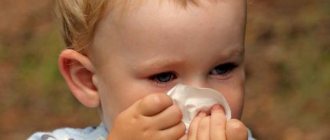What is a child's cough?
If a foreign object enters the respiratory tract, the body immediately tries to get rid of it by pushing it out with a stream of air and compressing the walls. This process is a physiological reaction - it is a reflex inherent in nature. The general mechanism is the same for a child and an adult. The defensive reaction itself can be observed not only to a large foreign body, which is often swallowed by a small child exploring the environment: even because of the flow of air that gets into the “wrong throat”, the baby is able to cough.
Cough without fever in a child
According to pediatricians, an infant coughs up to 10 times a day: the very sensitive mucous membrane of the respiratory tract, as dust particles, microorganisms, and other foreign bodies accumulate on it, tries to clear itself, which results in such a reflex. The frequency, intensity and nature of the attack may vary depending on:
- congenital characteristics of the body;
- humidity and cleanliness of the room;
- sensitivity to chemicals.
Experts assure that young parents should not be bothered by a child’s cough, which is not accompanied by fever, runny nose or other symptoms of serious diseases of viral or bacterial etiology. Even if it exceeds the indicated 10 times per day, we cannot exclude the most common cause - an allergic reaction, which in infancy can happen to literally everything. In a child older than one year, this is also a common case, but here we are no longer talking about situational manifestations of allergies caused by the body getting used to the environment, but about permanent ones.
Dangerous signs when coughing and when you need a doctor
Before treating a cough in a 10-year-old child, the cause of its occurrence should be determined. The symptoms accompanying the pathology will help to find out what kind of disease attacked the baby. Experienced mothers often do without drug treatment. They practice traditional medicine, inhalation, and heating. But it is important to know that there are cases when medical care is urgently needed. If it is timely, recovery comes many times faster.
Calling a doctor or visiting a clinic for examination and consultation is recommended when:
- The cough appeared unexpectedly and is accompanied by convulsions.
- If the pathological process does not stop within 5-7 days, or does not disappear after the disappearance of other signs of a cold.
- During sleep, attacks of pathology begin.
- When sputum is released, bloody impurities are observed.
Pay attention to the condition and appearance of your child during attacks. Sometimes the baby's skin becomes pale or takes on a blue tint. Do not delay examination by a pediatrician, so as not to aggravate the resulting pathology and carry out proper treatment of the disease.
Causes
A small child is characterized by allergic coughing (in severe cases, a strong “barking” cough, which may even make the baby cry), and simple physiological coughing – when any irritating elements enter the respiratory tract. However, it is possible to say exactly why a child coughs for a long time without fever only after studying the nature of the process - wet or dry, how intense, when it appears, whether it is constant.
A child can cough without fever or other symptoms of ARVI, regardless of age:
- after nervous shock, prolonged stress;
- as a response to contact with an allergen;
- during the development of tuberculosis;
- for nonspecific infectious diseases;
- due to congenital bronchial asthma.
- How to cook tomatoes for the winter
- Classic julienne - options for cooking at home using step-by-step recipes with photos
- A harmless habit that leads to premature death
Dry cough
If the child does not spit out mucus, or you hear a wheezing sound coming from the throat, this cough is called dry. According to doctors, it occurs more often than wet, mainly caused by external factors, although it can also be accompanied by acute inflammation of the trachea at the initial stage. If a dry barking sound comes from the baby, turns into attacks of suffocation, there is no temperature, the general condition is normal, there is a risk that a foreign object has entered the throat.
However, the situation can be more complicated:
- Colds are a common cause of dry cough, which is characterized by frequent attacks but low intensity. The baby may complain of “itch” in the throat, a feeling of “sand”. When listening to the chest, there is no wheezing; the attack does not interfere with normal breathing. As the cold progresses, sputum begins to be produced.
- Infection in the body. The temperature will appear in a day or a little later, and the child will become lethargic and capricious.
- Gastroenterological pathologies (mainly reflux disease) can also provoke a dry cough that occurs after eating. Vomiting is possible.
- A paroxysmal dry cough with signs of suffocation can occur in a baby suffering from whooping cough. Its characteristic feature is the appearance of tears in the eyes due to the intensity of the attack, protrusion of the tongue.
Protracted
If the attack lasts for a long time, the child cannot calm down, the eyes begin to water, but there is no temperature, there is a high probability that this is a reaction to the chemical composition of the air. Tobacco smoke, heavy metals, exhaust gases and even an abundance of perfume aromas in a child provoke a paroxysmal dry cough more actively than in an adult, since the sensitivity of the laryngeal mucosa in a child is higher. However, if the child is at home, the state of the environment has not changed, but he suddenly began to cough, and the attack is severe, these may be:
- symptoms of bronchitis;
- asthma attacks;
- manifestations of individual sensitivity to dry/cold air.
Special attention to a lingering cough, which is caused by a foreign body entering the larynx: it is active, can be observed for several weeks or even months, accompanied by wheezing, but does not progress - there will be no sputum production, no additional complications (fever, weakness, runny nose). In such a situation, you need to show the child to the doctor and take an x-ray.
Wet
In a small child who is at the stage of the appearance of his first teeth, young parents may notice a strong wet cough, even accompanied by salivation. If there is no high temperature, there is no need to be afraid of this symptom - it is typical for most babies. Among the normal physiological reactions of a small child’s body is coughing attacks after crying or eating: this often happens in infants. However, it is possible that a cough with sputum without fever in a child will indicate:
- inflammation of the respiratory tract;
- viral disease;
- remission of pneumonia;
- bronchitis;
- pulmonary tuberculosis;
- development of asthma.
At night
If your child has frequent seizures while he sleeps, see if they recur if he simply lies flat. If the answer is positive, the cause may lie in the presence of reflux, but the child will also complain of heartburn. If a baby has a strong cough at night, it is possible that the moment of teething is approaching - in such a situation, attacks will last no more than a few days. A child's prolonged cough at night without fever is a sign of residual or developing bronchitis.
No fever or runny nose
If the disease has affected only the mucous membrane of the bronchi, trachea or lungs, the child may look healthy. The cough is not accompanied by a runny nose, there is no fever, but the onset of attacks is mostly sudden, and they themselves are long and almost always characterized by sputum production; there is a risk that the development of dangerous diseases of the respiratory system has begun. They can accompany acute and chronic inflammation, and be a complication of frequent colds and reduced immunity.
Even if there is no fever, parents should be wary if sputum is released:
- abundant and has a rusty color - this is a symptom of pneumonia;
- contains pus – a lung abscess is possible;
- comes with blood - a characteristic sign of tuberculosis;
- has a watery consistency - this is characteristic of acute inflammation in the respiratory tract.
- How to find a phone number for free by address
- How to transfer your future pension to a non-state pension fund
- How coronavirus will affect the spring military draft
Cough and runny nose
The appearance of discharge from the nasal passages, in contrast to coughing attacks, in most cases is a symptom of an inflammatory process, so even the absence of temperature does not cast doubt on the activity of a virus or bacteria. In such a situation, treatment is prescribed not so much symptomatically, but with an emphasis on the source of the disease, since both a mild cold and a more dangerous flu can occur with these symptoms.
Rough cough
Heavy breathing, barking sounds when trying to clear your throat, frequent attacks are obvious symptoms of laryngitis or laryngotracheitis. These diseases are predominantly accompanied by swelling of the larynx, which, as they progress, provokes shortness of breath and increased coughing attacks closer to the morning, which requires calling a doctor. Fever and other symptoms of respiratory system diseases may be absent.
Folk cough remedy for children
Our ancestors used folk methods to treat children. Recipes for healing decoctions and tinctures have been passed down for generations. Folk remedies are more effective in combination with other methods of therapy.
Inhalation of saline solution or herbs that dilute sputum effectively combat dry cough. Modern medicine recommends using nebulizers for inhalation. Unlike thermal procedures using “grandmother’s methods,” inhalations using nebulizers can be carried out with a slight increase in temperature.
Mustard plasters help cope well with dry cough. For children 10 years old, the duration of the procedure should not exceed five minutes. When a child has a fever, this method of therapy is strictly prohibited.
Diagnostics
Most of the causes of cough are associated with diseases of the ENT organs, so to make a diagnosis, the child must first be shown to a pediatrician, and then to an otolaryngologist. The latter will definitely conduct a classical examination, examining the mucous membrane of the throat. Additionally:
- If an allergic cough occurs, you will need to take a detailed blood test and carefully describe the picture of the events that preceded the attacks.
- If you suspect the presence of a foreign body, you need to do an X-ray.
- If the cough is not a symptom of bronchial asthma, a sign of a cold or its residual phenomenon, is not associated with an allergy, and there is no runny nose with it, but it is wet and severe, lasts several weeks, you need to be examined by a phthisiatrician and a pulmonologist.
Possible consequences
Otitis media is a possible consequence of a cough without treatment.
If the cough does not go away for a long time, particularly in the absence of proper treatment, serious complications can begin.
- Oxygen starvation, which affects organs.
- Transition to chronic form. Affects the development of bronchial asthma.
- The vulnerability of the mucous membranes of the respiratory system leads to strong susceptibility to pathogenic microorganisms.
- A child's cough at night without fever can lead to otitis media or sinusitis. This happens because there is impaired breathing through the nose, exhaustion of the body, decreased immunity, and depression of the nervous system.
How to treat
If you observe a dry cough in children without fever, but with characteristic symptoms of a cold (runny nose, weakness, lethargy, loss of appetite), there is a chance of preventing the disease from starting. The baby should be provided with plenty of warm drinks: from tea and broth to herbal infusions. For infectious diseases, drugs are prescribed that strengthen the immune system and kill the virus, but additionally symptomatic therapy is needed.
Medicines
There is no point in using antitussive drugs for treatment, since they only suppress the symptom. The only reason why doctors can prescribe them is to relieve coughing attacks at night. The basis of drug therapy is drugs aimed at influencing the source of the problem:
- Taking antihistamines (Tavegil, Suprastin) is a mandatory measure for treating cough caused by allergies. This way you can achieve relief from attacks and relieve swelling that occurs when the larynx is inflamed due to contact of the mucous membrane with an allergen.
- It is recommended to treat only acute infectious diseases with antibiotics, if they cannot be eliminated otherwise. These are mainly drugs of the penicillin group and cephalosporins.
- The doctor prescribes mucolytics (Bromhexine, Ambrobene) for the treatment of chronic diseases accompanied by an unproductive cough. They are effective for pneumonia, bronchitis, laryngitis.
- The prescription of expectorant drugs is practiced in the absence of thick sputum. The most effective are Gedelix, Mucaltin.
Procedures
Doctors call massage with honey, which is applied to the child’s back, followed by light tapping, an effective method for treating wet cough. Additionally, you can use the following tips:
- Inhalations.
- If there is strong sputum production, pediatricians recommend rubbing the baby's back and chest with warming ointments at night.
- Active gargling is recommended for heavy phlegm: they are carried out at intervals of an hour.
- If the temperature is normal, hot foot baths (duration 15-20 minutes) make sense.
Folk remedies
Decoctions of herbs - sage, linden, oregano, which are drunk as immunity-strengthening agents, will also help the child's body. They will also help soothe the lining of the respiratory tract during inflammation, and mint and eucalyptus will relieve acute attacks. For the purpose of separating sputum, you can use fees that include:
- marshmallow root;
- licorice;
- plantain leaf.










